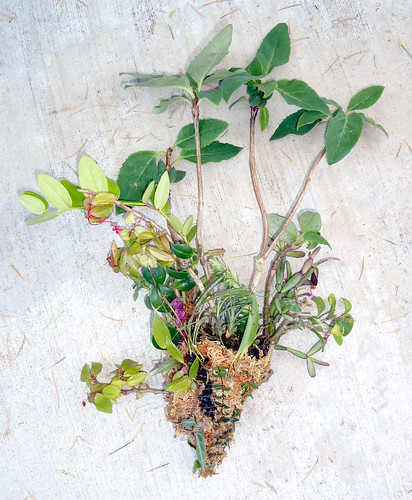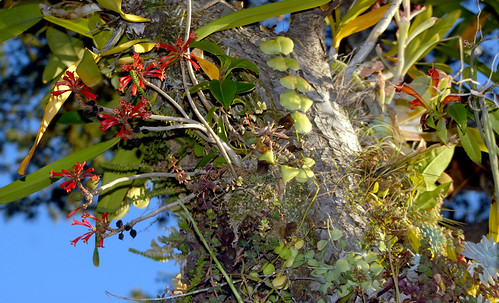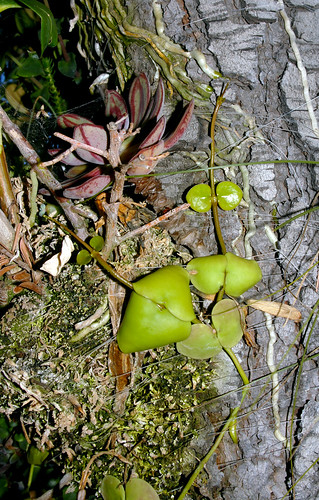May 2011 I added this bundle of plants to my Cedar tree...
Here's what the bundle included...
- Aeschynanthus hybrid - cutting
- Anthurium scandens (xeric form) - rooted
- Begonia NOID - cutting
- Campyloneurum angustifolium - cutting
- Cissus amazonica - cutting
- Dermatobotrys saundersii - rooted
- Disterigma pentandrum - cutting
- Ficus diversifolia (Variegated) - rooted
- Hatiora rosea - cutting
- Hoya engleriana - cutting
- Impatiens keilii - cutting
- Iresine herbstii - cutting
- Macleania insignis - rooted
- Medinilla sedifolia - cutting
- Pleurothallis palliolata - keiki
- Pleurothallis restrepioides - keiki
- Tillandsia albertiana
- Tillandsia butzii
Can you guess who the winner is?
Here's a photo of the bundle in 2013...
The Dermatobotrys and Anthurium were the only two survivors from the original bundle. Then maybe a year, or two, ago... because of the drought, I reduced watering from 3x/week to 2x/week during summer. The Dermatobotrys crashed and burned. But the Anthurium didn't even slow down. Here's a pic that I took yesterday...
The Anthurium would be a bigger specimen but I've shared quite a few cuttings over the years. The "flowers" are insignificant to say the least, but its berries go from white to a nice light purple. What's great about this species is that it's a drier grower. When I ordered it from Black Jungle I specifically requested the xeric form. I have a few other Anthuriums on my tree (ie coriaceum, schlechtendalii) but they are standing still compared to scandens.
The scandens beat a few other plants that I added to the bundle, including an Echeveria nodulosa that I added in 2012...
In the 2013 photo, if you look hard enough, you can still see it. But it never really did that well and slowly diminished away. This is somewhat surprising since nodulosa can sometimes be found growing epiphytically in its natural habitat.
The Dischidia cleistantha (shingler) did much better. It wasn't very happy though when I reduced watering to 2x/week. There are a couple places on the tree where it's still hanging on. Dischidia milne (bottom of 2013 pic and middle of 2017 pic), on the other hand, didn't have a problem with less frequent watering. It's more of a drier grower than Dischidia formosana (dangling in 2017 pic), which will die off if dry for too long. However, formosana is a lot faster than milne. I'm guessing it's partly because formosana probably grows in a wider range of temperatures.
Jumping back to Echeveria nodulosa... I recently saw this thread that Stan started for his. Seeing it reminded me that I was really interested in this Echeveria that oldstumpy1 had shared in this 2013 thread...
I shared the photos with John Trager and he said that it looks a bit like a cross between Echeveria rosea and nodulosa. For some reason I don't run across very many crosses with either. Here are a few exceptions...
Echeveria corrinea x rosea
Echeveria pulidonis x rosea (flowers)
Echeveria coccina x rosea
In my previous entry I mentioned that I'm currently germinating rosea seeds that were hopefully the result of pollen from Echeveria coccinea and/or gibbiflora. I wish that nodulosa had been one of the potential fathers!
The goal is to try and find/create an Echeveria that can easily beat Anthurium scandens here in Southern California. In theory it shouldn't be a mission impossible given that Echeverias are relatively easy to cross. The time it takes to accomplish this mission depends on the number of crosses tested. So let's test more crosses!






No comments:
Post a Comment